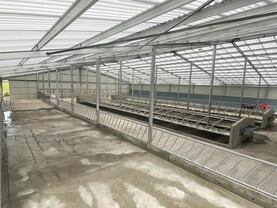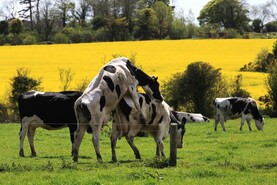Over the last three years considerable investment has been made on Robin Briggs’ dairy farm just outside of Maybole, Ayrshire. Kilhenzie Farm is currently milking 280 cows, with recent investments made on the farm focused on making life much easier for both farmer and cows.
Investment has been staggered on the farm over the past four years which has involved two new sheds, incorporating cubicles, a new dairy parlour, calving pens and bull pens. The Holstein herd produces approximately 9,000 litres per cow at 4.3% fat and 3.3% protein, with the plan for the future to move towards 10,000 litres.
The herd is predominantly grass-based, with the aim to get cows out to grass in mid-April, where they would stay until October. However, they would also get buffer-fed during parts of the summer. Cows will get fed to yield in the parlour for the majority of the year.
“If a cow is giving about 60kg a day of milk then they would probably be getting 8kg of concentrates,” according to Robin.
The first shed to be built is fitted with 280 cubicles and was constructed in 2014, with the second adjoining shed being built in 2015.
However, the milking parlour was not fitted into the second shed until 2017. When the first shed was constructed in 2014, all of the slatted tanks for the future shed were also installed. These slatted tanks run the full length of one end of the sheds while it also stretches under the collecting yard.
Both sheds are steel portal frame structures which allows for a wide unrestricted span, offering flexibility as to the internal layout of the sheds.
Pictures one and two
While a lot of farmers may be tempted to refurbish or upgrade their existing facilities, for Robin, this was not a route that he wanted to go down.
“We decided to go to a greenfield site rather than doing up the existing facilities. The old set-up would have needed a lot of investment and at the end of the day it would still be an old shed. I was probably planning the new sheds for over ten years before anything was done. I wanted things to be as simple and safe as possible.”
And that is just what Robin has achieved. With an emphasis put on cow flow and the ability of one man to move stock with ease, whether it is in and out of the parlour, or cows before and after calving. The entire layout of the project was meticulously planned with David Smith of Smith Contracts Scotland Ltd to ensure the safe and efficient movement of cows throughout the sheds.
It is not just movement of cows that Robin considered, with slip though points in place throughout the shed for safety.
“Air and light were key when we were designing these sheds. We have LED lights fitted throughout the shed and these are on timers. It is set-up to provide 16 hours of light and eight hours of darkness,” according to Robin.
Overall the sheds are very airy with spaced boarding along one gable end of both sheds, while one side of the shed is completely open, and the other is fitted with spaced sheeting.
One key design aspect of the shed is that cows are over slats for the majority of the time once they enter the shed for milking. Once cows exit the parlour they will also go back onto slats as they exit the shed. This greatly reduces the amount of washing down that is required.
Once cows exit the parlour they go through a footbath and an automatic three way GEA drafting system, where they can be directed to a holding pen if they are in heat or have any health issues that need further inspection.
Running alongside the drafting unit is a large calving area. This is made up of a loose area and four individual calving pens. A large straw bedded pen is in place beside this that has been used to house young stock up until this point, but the plan now is to install cubicles in this section of the shed also.
Picture three
Adjoining the calving pens are two bull pens. These heavy-duty pens have been installed to house the stock bulls over the winter months with safety a key feature on the farm. Gates at the back of the pens have been stock-boarded to provide shelter for bulls.
Pictures four, five and six
An 18-unit GEA parlour with swing over arms and automatic cluster removers was chosen for the parlour.
“I choose GEA as I wanted the backflush and autospray features to prevent cross contamination between cows. The GEA cow scout collars also work with the drafting unit,” Robin explained.
“I would be able to comfortably milk 100 cows per hour in the new parlour. Having good facilities also makes it easier to get additional labour to work on the farm as it is a much more appealing prospect for someone.”
Individual feeders are in place in the parlour with a zig-zag rump rail also installed. Individual feeding bails were decided upon for the parlour so that cows which are in need could be targeted with extra meal when necessary. Batch feeding is also a possibility.
A large fan was installed at one end of the parlour too which has proven to be very useful to prevent the pipes from freezing over the past winter.
Picture seven
The decision was made to install Duraflake resin wall coating both in the parlour and throughout other areas of the shed. “I had seen it on another farm and I really liked it. It is easier to clean down and helps protect against algae and mould,” Robin said.
Pictures eight and nine
The cubicle shed is 125ft wide and 200ft long. Space was central to the design in a bid to reduce the level of bullying which takes place. Large 17ft-wide passageways run along the feed barriers ensuring ample room for cows to manoeuvre along the feed face.
Crossover points are located at either end of the shed as well half way down both rows of cubicles. The central rows of cubicle beds are 16ft with individual cubicles measuring 6ft from the heel to the brisket board. Cubicles are 3ft 9in wide also.
Four automatic rope scrapers run the full length of the shed.
Heavy-duty, high-volume water troughs are in place in four crossover points throughout the shed. Robin made the decision to go for concrete troughs as he believes they are more robust.
Outlet ventilation is provided by a continuous opening running along the full length of the apex of the shed.
“I am only going to do this once and I didn’t want to cut any corners,” Robin concluded.
“The shed is well designed to allow for a good flow of air and cows, both of which are vital,” according to David Smith of Smith Contracts Scotland Ltd who completed the entire project.
“Not every farmer would plan so far ahead and stagger the investment but it is good not only from a cashflow point of view but also to see how each individual section of the shed is working.”






 This is a subscriber-only article
This is a subscriber-only article



















SHARING OPTIONS: